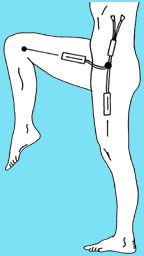H35 ROM/Sit & Reach

Measuring hip joint angle with an electrogoniometer in conjunction with the standard sit-and-reach test, the straight leg flexion test, and visual observation may allow an examiner to more effectively assess the flexibility of the individual.
Experimental Objectives
-
To measure hamstring and back flexibility using a standard sit-and-reach test and determine whether the measures fall within accepted normative ranges.
-
To measure hip joint range of motion and hamstring flexibility through the use of an electrogoniometer DURING the sit-and-reach test.
-
To measure hip joint range of motion and hamstring flexibility, performing a supine straight-leg raise (passive or active), through the use of an electrogoniometer and compare to normative values.
- Have a lab partner perform visual comparisons of the range of motion of the hip joint during each of the three activities and record the observations.
Tasks Performed by the Student
Subject will:
-
sit on the floor with feet up against the sit-and-reach box and legs next to one another
-
lean forward with one hand over the other and slowly reach forward as far as possible, three times, holding the position on the third reach for at least 2 seconds
Condition 2
-
slowly lift one leg (side with the goniometer), keeping the other leg flat on the floor
-
keep both legs straight
-
continue to the endpoint and then hold for several seconds
- slowly lower the leg to the floor
Videos
Biopac Student Lab Student Download
Student Prep & Distance Learning
Click the link(s) below for sample data and/or lesson procedure video(s), BSL PRO Lesson procedures (PDF) for human lessons*, and graph template files (*.gtl) for BSL PRO Lessons. If more than one .gtl is available, download the .gtl with the _suffix to match BSL version and hardware.
Lesson Hardware
This lesson requires a Biopac Student Lab (BSL) System and the following hardware. If your BSL System does not include all hardware items, expand your system by selecting required items below. For more details, review the Lesson: L# BSL Lessons - see the Lab Manual or launch BSL; A# and H# BSL PRO Lessons, click the PDF link above to review full setup, recording, and analysis procedures.
| Item | Name | Cart |
|---|---|---|
| SS21L | Twin-axis Goniometer 150mm, BSL | Add to Cart |
| TAPE2 | Adhesive Tape, double-sided, 25.6m | Add to Cart |
Stay Connected